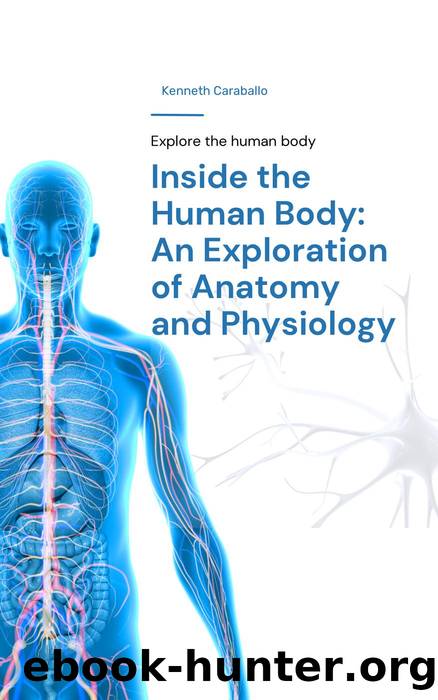Inside the Human Body: An Exploration of Anatomy and Physiology by Kenneth Caraballo

Author:Kenneth Caraballo
Language: eng
Format: epub
Tags: science, science education, education, anatomy, Physiology
Publisher: Kenneth Caraballo
Published: 2023-03-01T00:00:00+00:00
Chapter 30: The Male Reproductive System: Prostate and Seminal Vesicles
The male reproductive system is responsible for producing and delivering sperm to fertilize the female egg. It is made up of several organs, including the testes, epididymis, vas deferens, prostate gland, seminal vesicles, and penis. In this chapter, we will focus on the prostate gland and seminal vesicles, which play crucial roles in the production and delivery of semen.
The Prostate Gland
The prostate gland is a walnut-sized gland located just below the bladder in males. It surrounds the urethra, which is the tube that carries urine from the bladder out of the body, and is therefore involved in both urinary and reproductive functions. The prostate gland secretes a milky fluid that forms part of the semen, which is ejaculated during sexual intercourse.
The fluid produced by the prostate gland contains a variety of substances, including enzymes, proteins, and minerals. One of the enzymes, prostate-specific antigen (PSA), helps to liquefy the semen so that it can be easily ejaculated. Another enzyme, acid phosphatase, helps to break down proteins in the semen. The fluid also contains zinc, which is necessary for sperm production, and citric acid, which provides energy for the sperm.
Seminal Vesicles
The seminal vesicles are a pair of small glands located behind the bladder and in front of the rectum. They secrete a fluid that makes up a significant portion of the semen. The fluid contains fructose, which provides energy for the sperm, and prostaglandins, which help to dilate the cervix and uterus to facilitate fertilization.
The seminal vesicles also produce a protein called semenogelin, which helps to coagulate the semen after ejaculation. This coagulation is important because it helps to keep the semen in the vagina long enough for the sperm to reach the egg. Over time, the semenogelin is broken down by enzymes in the female reproductive tract, allowing the sperm to continue their journey.
30.3 Semen
Semen is the fluid that is ejaculated during sexual intercourse. It is composed of sperm, which are produced in the testes, and fluids from the prostate gland and seminal vesicles. In addition to the substances discussed above, semen also contains other proteins and hormones, as well as various ions and nutrients.
The volume of semen that is ejaculated can vary, but on average it is about a teaspoonful. Each ejaculation contains millions of sperm, but only a small percentage of these sperm will reach the egg and be capable of fertilization.
Sexual Function
The prostate gland and seminal vesicles play important roles in sexual function. The fluid produced by the prostate gland helps to lubricate the urethra and neutralize the acidic environment of the vagina, which can be hostile to sperm. The fluid also contains a variety of substances that help to stimulate and prolong sexual arousal.
The fluid produced by the seminal vesicles, as discussed above, provides energy for the sperm and helps to dilate the cervix and uterus to facilitate fertilization. In addition, the fluid contains substances that help to stimulate and prolong sexual arousal.
Disorders of the Prostate and Seminal
Download
This site does not store any files on its server. We only index and link to content provided by other sites. Please contact the content providers to delete copyright contents if any and email us, we'll remove relevant links or contents immediately.
Whiskies Galore by Ian Buxton(41866)
Introduction to Aircraft Design (Cambridge Aerospace Series) by John P. Fielding(33064)
Rewire Your Anxious Brain by Catherine M. Pittman(18551)
Craft Beer for the Homebrewer by Michael Agnew(18140)
Cat's cradle by Kurt Vonnegut(15178)
Sapiens: A Brief History of Humankind by Yuval Noah Harari(14242)
Leonardo da Vinci by Walter Isaacson(13179)
The Tidewater Tales by John Barth(12608)
Thinking, Fast and Slow by Kahneman Daniel(12065)
Underground: A Human History of the Worlds Beneath Our Feet by Will Hunt(12020)
The Radium Girls by Kate Moore(11921)
The Art of Thinking Clearly by Rolf Dobelli(10209)
A Journey Through Charms and Defence Against the Dark Arts (Harry Potter: A Journey Throughâ¦) by Pottermore Publishing(9221)
Mindhunter: Inside the FBI's Elite Serial Crime Unit by John E. Douglas & Mark Olshaker(9186)
Tools of Titans by Timothy Ferriss(8211)
Wonder by R. J. Palacio(8004)
Turbulence by E. J. Noyes(7935)
Change Your Questions, Change Your Life by Marilee Adams(7633)
Nudge - Improving Decisions about Health, Wealth, and Happiness by Thaler Sunstein(7611)
